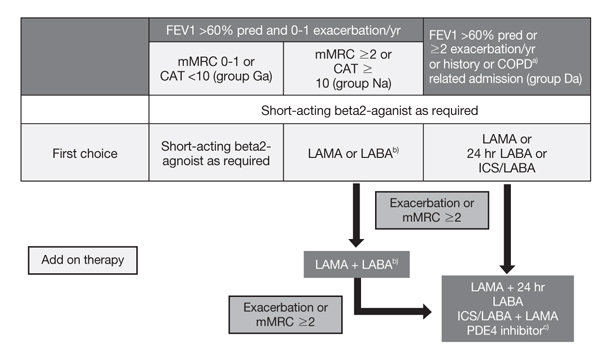J Korean Med Assoc.
2014 Feb;57(2):155-158.
Recent advance in inhaler medications for chronic obstructive pulmonary disease patients
- Affiliations
-
- 1Department of Pulmonary and Critical Care Medicine, Asan Medical Center, University of Ulsan College of Medicine, Seoul, Korea. ymoh55@amc.seoul.kr
Abstract
- Chronic obstructive pulmonary disease (COPD) is one of the highest ranking diseases with regard to prevalence and mortality in Korea and also worldwide. In the past decade, effective inhaler medications for COPD treatment have been developed or approved. These inhaler medications have been proven to have beneficial effects on symptoms, lung function, quality of life, exercise capacity, and exacerbation. The inhalers used widely are long-acting anticholinergics, long-acting beta2-agonists, and combined inhalers of a corticosteroid and long-acting beta2-agonist. These inhaler medications are more effective than oral medications and less likely to produce adverse events. However, the inhaler medications should be used appropriately to achieve the desired effect. For COPD patients with a forced expiratory volume in 1 second (FEV1) less than 80% of the predicted value, a long-acting anticholinergic or long-acting beta2-agonist is usually the medication of first choice. If a COPD patient with a FEV1 less than 60% of the predicted value suffers frequent exacerbations, a combined inhaler of corticosteroid and long-acting beta2-agonist is a good choice. To prescribe an inhaler medication for COPD patients, spirometry should be performed, not only to confirm the diagnosis but also to define severity. These effective inhaler medications should be used widely for COPD patients in Korea.
Keyword
MeSH Terms
Figure
Reference
-
1. Global Initiative for Chronic Obstructive Lung Disease. Global strategy for the diagnosis and management, and prevention of COPD [Internet]. [place unknown]: Global Initiative for Chronic Obstructive Lung Disease;2013. cited 2014 Jan 17. Available from: http://www.goldcopd.org/Guidelines/guidelines-global-strategy-for-diagnosis-management.html.2. Hwang YI, Yoo KH, Sheen SS, Park JH, Kim SH, Yoon HI, Lim SC, Lee SY, Park JY, Park SJ, Seo KH, Kim KU, Lee SY, Park IW, Lee SD, Kim SK, Kim YK, Lee SM, Han SK, Kim Y, Cho YM, Park HJ, Oh KW, Kim YS, Oh YM. Prevalence of chronic obstructive pulmonary disease in Korea: the result of forth Korean National Health and Nutrition Examination Survey. Tuberc Respir Dis. 2011; 71:328–334.
Article3. Statistics Korea. Cause of death in South Korea [Internet]. Dae-jeon: Statistics Korea;2013. cited 2014 Jan 17. Available from: http://kostat.go.kr/portal/korea/kor_nw/2/6/2/index.board.4. Nici L, Donner C, Wouters E, Zuwallack R, Ambrosino N, Bourbeau J, Carone M, Celli B, Engelen M, Fahy B, Garvey C, Goldstein R, Gosselink R, Lareau S, MacIntyre N, Maltais F, Morgan M, O'Donnell D, Prefault C, Reardon J, Rochester C, Schols A, Singh S, Troosters T. ATS/ERS Pulmonary Rehabilitation Writing Committee. American Thoracic Society/Euro-pean Respiratory Society statement on pulmonary rehabilitation. Am J Respir Crit Care Med. 2006; 173:1390–1413.
Article5. Korean Academy of Tuberculosis and Respiratory Diseases. COPD guideline revised 2012 [Internet]. Seoul: Korean Academy of Tuberculosis and Respiratory Diseases;2012. cited 2014 Jan 17. Available from: http://www.lungkorea.org/thesis/file/COPD%C1%F8%B7%E1%C1%F6%C4%A7_%C3%D6%C1%BE%BA%BB.pdf.
- Full Text Links
- Actions
-
Cited
- CITED
-
- Close
- Share
- Similar articles
-
- Inhalation medications in chronic airway disease
- Continued Innovation in Respiratory Care: The Importance of Inhaler Devices
- Inhaler Competency and Medication Adherence in Older Adults and Adults with Obstructive Lung Disease
- Assessment of Inhaler Satisfaction and Determinants of High Satisfaction Among Korean COPD Patients
- Cor Pulmonale with Particular Reference to Chronic Obstructive Pulmonary Disease and Pulmonary Tuberculosis


